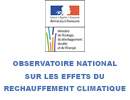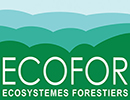Quantification of fluxes and stocks of carbon at the national and European levels
Quantification of fluxes and stocks of carbon at the national and European levels
The main objective of the CARBO-CONTROLE project is to quantify CO2 fluxes on the European scale and carbon stocks and fluxes at the national level. The scientific strategy adopted is to disaggregate – or downscale – fluxes (>100 km) by inversing atmospheric CO2 readings, and to aggregate – or upscale – national stocks and fluxes using climatic fields and satellite information.
To achieve this, the authors used numeric codes that will subsequently be validated by observation: (I) the three-dimensional atmospheric transport model TM2 and (II) the STOMATE model of the carbon cycle in soils and vegetation, which integrates a semi-empirical parameterization of the biogeochemical processes in ecosystems. These two codes use supercomputers. They were developed and partly validated for the carbon cycle at the global level. They were used in the CARBO-CONTROLE project concerning Europe and France in particular.
The project comprises two complementary subsets: (I) an inversion of the European carbon balance based on readings of atmospheric CO2 concentrations and (II) a simulation of French carbon fluxes and stocks and of their variability.
The inversion of the atmospheric fields will be carried out using a Bayesian method that optimizes CO2 sources and sinks over large regions while minimizing the distance between observed concentrations and the concentrations obtained through the transport model. The authors divided Europe into a number of regions, for which the fluxes were estimated. The uncertainties attached to this approach (density of the measuring network, errors in the simulation of atmospheric transport) were quantified.
The evaluation of carbon fluxes and stocks with the biogeochemical model was carried out with the STOMATE model. The fields of boundary conditions of the model (vegetation index, climate, etc.) were prepared with a resolution of approximately 20 km, after which several simulations were performed for France. The authors will also examine the sensitivity of stocks and fluxes to the parameters of the model, which will help them estimate the uncertainties of the method.
The CARBO-CONTROLE project comes as part of a series of research projects from LSCE and its partners (listed below). Although these projects share the same methods regarding modelling, the actions proposed in the CARBO-CONTROLE project are entirely original and receive no complementary funding. The other LSCE research projects include FRAISE (national programme CNRS-INSU: inversion of fluxes for the North Atlantic and Indian Oceans), EUROSIB (EEC project 1999-2001: airborne measurements of CO2 and intensive campaigns in Russia and Siberia) and CSOA-INSU (permanent support for the LSCE atmospheric observatories, in Ireland and New Amsterdam).
| Coordinators |
Philippe Ciais, IPSL – LSCE |
| Partnership |
Université Versailles Saint Quentin en Yvelines |
| Funding |
MEDD
|
| Budget |
114 336.76 € (including tax)
|




